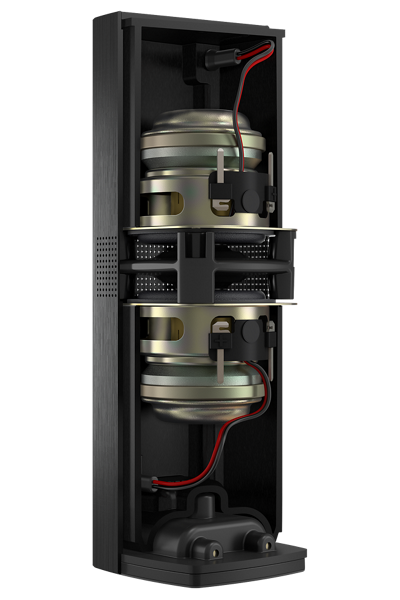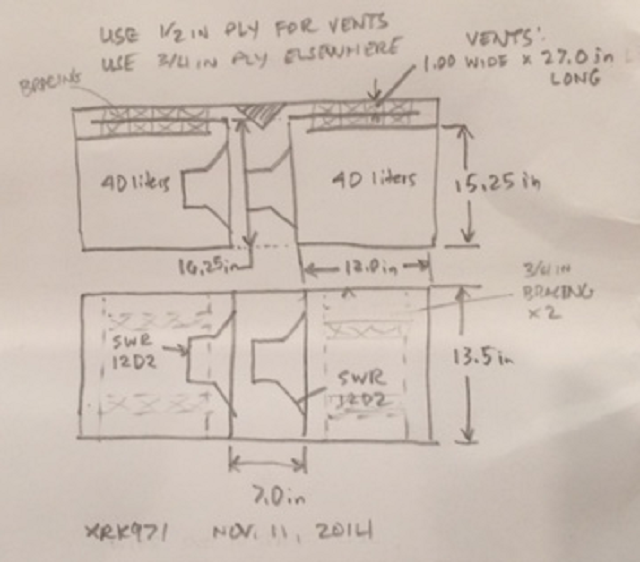I don't think bringing the name BOSE might go well with people!
But, there are some decisions which makes me wonder why they are taken and the benefits which it might bring!
As title suggests, I'm still wondering the decisions that went through when these speakers were finalized.
Why use a dual opposed driver for full range?
What advantages and disadvantages does this setup bring?
Can this work on any other driver?
Your thoughts please?
(Attached the image just for information! Credits:BOSE)

But, there are some decisions which makes me wonder why they are taken and the benefits which it might bring!
As title suggests, I'm still wondering the decisions that went through when these speakers were finalized.
Why use a dual opposed driver for full range?
What advantages and disadvantages does this setup bring?
Can this work on any other driver?
Your thoughts please?
(Attached the image just for information! Credits:BOSE)

This is basically a slot loaded 6th order bandpass subwoofer. They make very deep bass and are capable of higher power input since the cone movement is very well controlled. The opposed driver arrangement cancels mechanical vibration. The downside is that the geometry is touchy and driver T/S parameters need to be very accurately reproduceble to make it suitable for production. I have designed and other have built my designs with success. Akabak can model this pretty easily.
Here is the basic concept:

For example:
PP Slot Loaded Sub with Alpine SWR 12D2
Or one made of XPS foam:
Light as Air Slot Loaded Band Pass Sub
The idea is that the rear chamber exit vents pass by the cone front and this serves as an acoustical feedback mechanism to help control the cone motion. The output can be tuned to be amazingly flat yet deep. Auto sound competitions often use this alignment because it can achieve extreme SPL >130dB in very compact volumes.
Here is the basic concept:

For example:
PP Slot Loaded Sub with Alpine SWR 12D2
Or one made of XPS foam:
Light as Air Slot Loaded Band Pass Sub
The idea is that the rear chamber exit vents pass by the cone front and this serves as an acoustical feedback mechanism to help control the cone motion. The output can be tuned to be amazingly flat yet deep. Auto sound competitions often use this alignment because it can achieve extreme SPL >130dB in very compact volumes.
Last edited:
Bose is marketing these as wireless omni surround speaker not a sub...
and looking at the photo i'm wondering where the vent structures hiding...
and looking at the photo i'm wondering where the vent structures hiding...
Last edited:
Thanks a lot for the replies guys..
The reason for the query is, I'm planning to build a similar with 3 inch drivers, so that the rear surrounds remains discreet.
Since it needs to function as a rear surround, I think this concept might work.
Not sure how do I make the deflector plate/sheet.
BTW, how the deflector plate is designed? is only the geometry of the speaker is fine or does it depend on the T/S parameters as well.
Importantly, What made Bose to choose this design than the normal front facing ones. I believe the front facing ones are easy to make.
Do they cancel any distortion as they are opposed? Can they take more power and reach high SPL? these are other things that runs in my mind. any thought would be helpful.
The reason for the query is, I'm planning to build a similar with 3 inch drivers, so that the rear surrounds remains discreet.
Since it needs to function as a rear surround, I think this concept might work.
Not sure how do I make the deflector plate/sheet.
BTW, how the deflector plate is designed? is only the geometry of the speaker is fine or does it depend on the T/S parameters as well.
Importantly, What made Bose to choose this design than the normal front facing ones. I believe the front facing ones are easy to make.
Do they cancel any distortion as they are opposed? Can they take more power and reach high SPL? these are other things that runs in my mind. any thought would be helpful.
Bose is marketing these as wireless omni surround speaker not a sub...
and looking at the photo i'm wondering where the vent structures hiding...
Though this is a wireless set, these can be driven wired with the lifestyle series. Thus, its just a normal speaker electrically!
But why Bose went with this arrangement?
This is basically a slot loaded 6th order bandpass
These are full range speakers! Not subwoofers.
Moreover, they are not Isobaric, nor 6th order, as the rear chamber is sealed.
Thus, it should make 4th order.
But would this arrangement work on Fullrange? wouldn't highs be compromised as the wavelengths are short?
Why a company bashed for using cheap components, go to the extent of designing a system like this?
If they are able to do and sell, why us, the DIY guys are not trying to do it?
Note: Sorry for back to back posts. This thought is running at the back of my mind and i can't stop my excitement when people are replying.
just conjecture but dual opposing would have greater output and keep the vertical polars tidy.
if you look at early omni designs with a single driver and a reflector they where ok horizontally but the response in the vertical plane varies drastically, and is likely what faded them into unpopularity...
if you look at early omni designs with a single driver and a reflector they where ok horizontally but the response in the vertical plane varies drastically, and is likely what faded them into unpopularity...
The deflector shape depends on what radiation pattern you want, most omni's aren't really omni, they are designed to produce more of a toroid, doughnut, shape 🙂 The simplest thing is to use a ball like some of the Duevel speakers.
3D printers take the fun out of painstaking hard to replicate manual labor....where's the DIY in that, that should have a new acronym MTRDI (make the robot do it)😛
Ok - I couldn’t tell by their size that they were “full range”. Not too much highs will pass through that perforated screen? I thought I saw channel ducts from the rear chamber to the front radial slot like so:

Maybe they are using that but to achieve bass maybe to 80Hz. Then they trick you into thinking you hear 40Hz bass.
Maybe they are using that but to achieve bass maybe to 80Hz. Then they trick you into thinking you hear 40Hz bass.
Attachments
both reflectors can be clearly seen - does B use EQ contouring? One might print a clamshell to hold two drivers
https://i.imgur.com/9kM0h9G.png
https://i.imgur.com/9kM0h9G.png
Hi,
I actually seen and heard this before. they are really tiny, meant to be mounted on a wall. The drivers that bose use are typically 2" I believe.
IMHO the purpose is constant directivity. In other words same frequency response from all directions.
The reason is simple. If you took a normal speaker and faced them to the front, the treble response falls as you move off axis. If you sat in the centre frequency response is identical from both sides. But if you moved left, the left side treble response increases and right side decreases. Suddenly your entire sound stage shifts left... The sweet spot becomes very narrow. Unless of course your tweeter is highly dispersive.
To overcome that people typically toe in the speaker to face the centre so the frequency response don't change that much. Or even cross it in front if the listener.
The missus is not going to be happy about it.
There is this other factor that Bose systems like reflected sound and that creates a large soundstage. That is why the cubes have two drivers that point in different directions.
Do let us know how your experiment worked out. You need to boost the treble quite a bit unless your speaker already has a rising response.
Oon
I actually seen and heard this before. they are really tiny, meant to be mounted on a wall. The drivers that bose use are typically 2" I believe.
IMHO the purpose is constant directivity. In other words same frequency response from all directions.
The reason is simple. If you took a normal speaker and faced them to the front, the treble response falls as you move off axis. If you sat in the centre frequency response is identical from both sides. But if you moved left, the left side treble response increases and right side decreases. Suddenly your entire sound stage shifts left... The sweet spot becomes very narrow. Unless of course your tweeter is highly dispersive.
To overcome that people typically toe in the speaker to face the centre so the frequency response don't change that much. Or even cross it in front if the listener.
The missus is not going to be happy about it.
There is this other factor that Bose systems like reflected sound and that creates a large soundstage. That is why the cubes have two drivers that point in different directions.
Do let us know how your experiment worked out. You need to boost the treble quite a bit unless your speaker already has a rising response.
Oon
- Home
- Loudspeakers
- Full Range
- Please Explain: Bose Omnijewel speaker!
